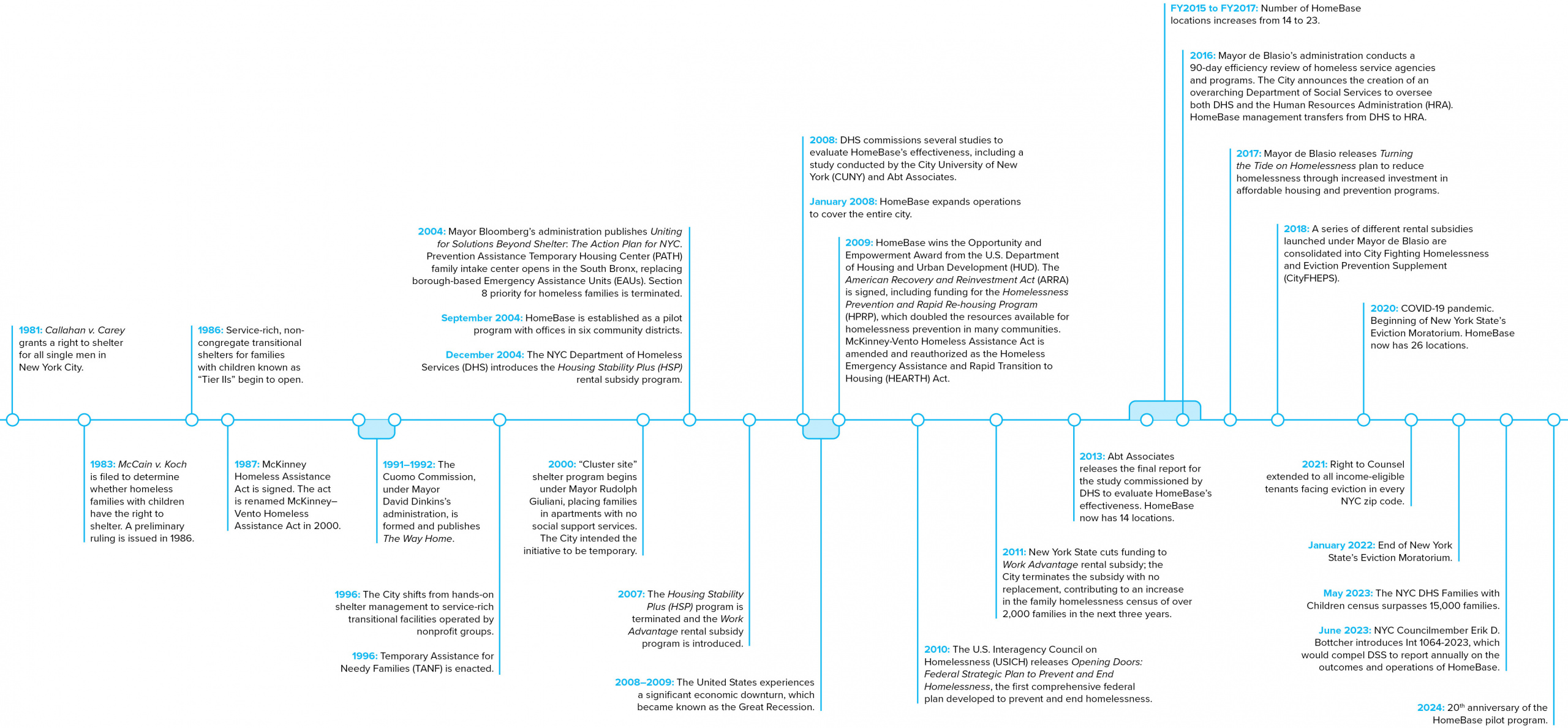By: James Dysart, Associate Policy Director and Lucia Stein, Policy Assistant
Due to uncertainty regarding federal funding, homelessness prevention services in New York City could need additional support to continue their proven history of success. To prevent a crisis for families with children, the City and State may need to dip deep into their pockets or develop new solutions to avoid a budget shortfall.
New York City’s HomeBase model has been a blueprint for homelessness prevention nationally for over 20 years. The program is a network of community-based organizations managed by NYC’s Human Resources Administration (HRA).Each year, HomeBase assists tens of thousands of New Yorkers with prevention services, with the goal of keeping at-risk families from moving into emergency shelter.1 Some of the ways HomeBase assists families are by connecting them to free legal representation, processing potential One-Shot Deals to pay off rental arrears, and issuing CityFHEPS housing vouchers. We know that when families receive services, they are likely to be diverted from entering the New York City shelter system. According to the Mayor’s Management Report (MMR) for Fiscal Year 2024, nearly 96% of families with children who received assistance through HomeBase did not enter the shelter system.2 However, there are growing concerns over access to HomeBase in NYC, including timeliness of appointments and stagnant funding.3 This capacity strain should be considered in the context of an increase in family homelessness, and it will only worsen should a potential decrease in federal support come to fruition.
Federal dollars make up a majority of the funding for HomeBase. According to the Office of the New York City Comptroller, federal dollars fund 61% of HomeBase’s $59 million budget.4 Federal funding that contributes to these successful prevention efforts is sourced from programs like Temporary Aid to Needy Families (TANF) and Emergency Solutions Grants (ESG). These funds face proposed reductions in the federal FY 2025 budget, with concerning implications right here in New York. HRA also manages programs like the Supplemental Nutrition Assistance Program (SNAP), which provides nutrition assistance to millions, including approximately one in five children in the United States.5,6 The loss of federal dollars may impact local budget decisions. Officials will want to minimize costs while managing a high need for social services. HomeBase services are not only less expensive than paying to keep a family in shelter but also reduce the length of stay for families if they end up entering the system.7 Through dedicated local and state investment in prevention, shelters, housing voucher assistance, housing development, and aftercare, New York City can take steps now to curb family homelessness despite austerity measures. Common sense dictates using limited resources in a targeted manner to gain the best outcomes for those most in need.
ICPH’s report, FROM LOCAL PILOT TO NATIONAL MODEL: HomeBase at 20 Years and Its Impact on Housing Insecure Families in NYC, looks at the history of HomeBase and can provide lessons to consider when faced with federal uncertainty and looming cuts to human services funding.
- New York City Mayor’s Office of Operations. (2025). Preliminary Mayor’s management report fiscal year 2025 (p. 204) https://donbuqm3ub5fw.cloudfront.net/files/PMMR_2025_Cover_817ffc435e.pdf
- New York City Mayor’s Office of Operations. (2025). Mayor’s management report fiscal year 2024 (p. 239) https://www.nyc.gov/assets/operations/downloads/pdf/mmr2024/2024_mmr.pdf
- The New York City Council – Meeting of Committee on General Welfare on 1/27/2025 at 10:00 AM
- Office of the New York City Comptroller, Brad Lander. (2025). Federal Funding Support for Human Service Agencies. Comptroller.nyc.gov. https://comptroller.nyc.gov/services/federal-funding-support-for-human-service-agencies/
- Center on Budget and Policy Priorities. (2025). 2025 Budget Stakes: Vulnerable People Could Be Targeted for Painful Cuts. 2025 Budget Stakes: Vulnerable People Could Be Targeted for Painful Cuts | Center on Budget and Policy Priorities
- Center on Budget and Policy Priorities. (2025) 2025 Budget Stakes: Millions Could Lose Needed Food Assistance. 2025 Budget Stakes: Millions Could Lose Needed Food Assistance | Center on Budget and Policy Priorities
- Institute for Children, Poverty & Homelessness. (2024) FROM LOCAL PILOT TO NATIONAL MODEL: HomeBase at 20 Years and Its Impact on Housing Insecure Families in NYC. https://www.icph.org/reports/from-local-pilot-to-national-model-homebase-at-20-years-and-its-impact-on-housing-insecure-families-in-nyc/#introduction
